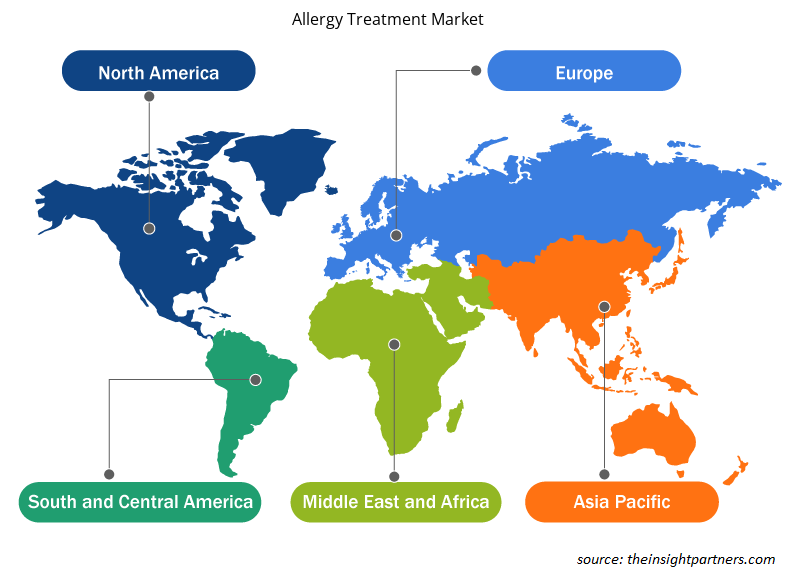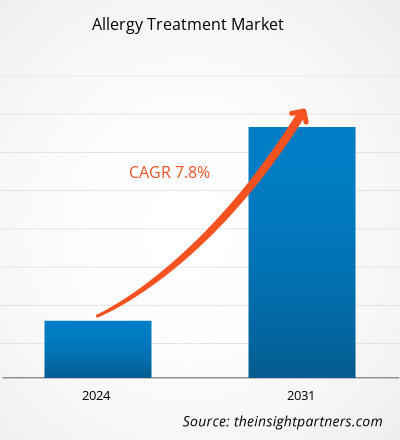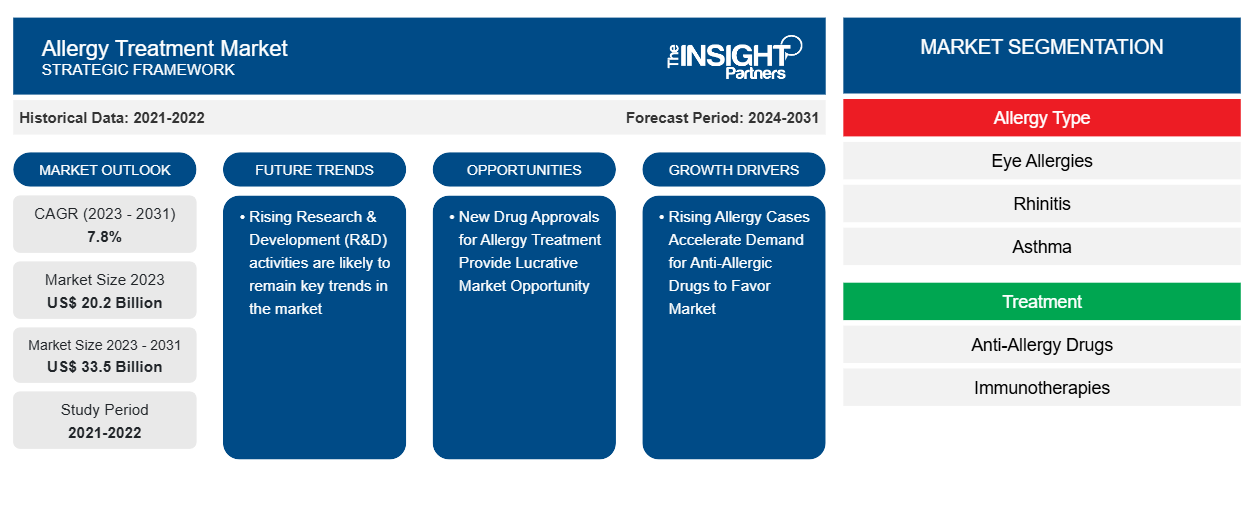Der Markt für Allergiebehandlungen soll von 20,2 Milliarden US-Dollar im Jahr 2023 auf 33,5 Milliarden US-Dollar im Jahr 2031 anwachsen. Für den Zeitraum 2023–2031 wird ein durchschnittliches jährliches Wachstum von 7,8 % erwartet. Steigende Forschungs- und Entwicklungsaktivitäten (F&E) werden voraussichtlich weiterhin wichtige Trends auf dem Markt bleiben.
Marktanalyse für Allergiebehandlung
Steigende F&E-Aktivitäten zur Behandlung von Allergien zur Entwicklung innovativer Medikamente werden in den kommenden Jahren wahrscheinlich ein neuer Markttrend bleiben. Obwohl es auf dem Markt mehrere Allergiemedikamente gibt, werden viele Patienten mit Atemwegsallergien und Asthma immer noch nicht ausreichend kontrolliert oder mit einer symptomatischen Therapie unzureichend behandelt. Beispielsweise bergen mehrere Atemwegsallergien das Risiko, Asthma zu entwickeln. Daher entwickeln mehrere Top-Hersteller klinische Studienprogramme für Allergien. Die „Allergen Immunotherapies“ von HAL Allergy BV für Atemwegsallergien für eine klinische Studie sind ein Beispiel dafür. Steigende F&E-Aktivitäten werden daher zur Entwicklung neuartiger Antiallergika führen und in den Jahren 2021–2031 für erhebliches Marktwachstum sorgen.
Marktübersicht zur Allergiebehandlung
Laut dem Bericht der Asthma Allergy Clinic zeigen neue Daten der Weltallergieorganisation (WAO), dass 14 % der Bevölkerung Asthma haben und 20 % an allergischer Rhinitis (AR) leiden, einer durch IgE vermittelten Entzündung der Nasenschleimhaut . Derzeit leiden etwa 20 bis 30 % der Bevölkerung Indiens an einer oder mehreren allergischen Erkrankungen, und die Prävalenz wird in den kommenden Jahren weiter steigen. Daher werden steigende Allergiefälle im kommenden Jahrzehnt die Nachfrage nach Antiallergika beschleunigen.
Passen Sie diesen Bericht Ihren Anforderungen an
Sie erhalten kostenlose Anpassungen an jedem Bericht, einschließlich Teilen dieses Berichts oder einer Analyse auf Länderebene, eines Excel-Datenpakets sowie tolle Angebote und Rabatte für Start-ups und Universitäten.
-
Holen Sie sich die wichtigsten Markttrends aus diesem Bericht.Dieses KOSTENLOSE Beispiel umfasst eine Datenanalyse von Markttrends bis hin zu Schätzungen und Prognosen.
Treiber und Chancen auf dem Markt für Allergiebehandlungen
Steigende Allergiefälle beschleunigen die Nachfrage nach Antiallergika und begünstigen den Markt
Laut dem Bericht der American Academy of Pediatrics ist Heuschnupfen (allergische Rhinitis) die häufigste Allergieart, die auch für die hohen Behandlungskosten verantwortlich ist. So belaufen sich die direkten und indirekten Kosten für eine Allergiebehandlung auf über 7 Milliarden US-Dollar pro Jahr. Eine gute Allergiebehandlung basiert daher auf der Krankengeschichte, den Ergebnissen von Allergietests und darauf, ob die Symptome leicht oder schwer sind. Darüber hinaus ist eine Immuntherapie für manche Allergiepatienten eine effektive Behandlungsoption. Es gibt zwei gängige Arten der Immuntherapie. Dazu gehören Allergiespritzen und die sublinguale Immuntherapie (SLIT). Bei Allergiespritzen werden Allergene injiziert; die Dosis wird mit der Zeit immer höher. Außerdem wird die Person zunehmend weniger empfindlich auf das Allergen, da diese Spritzen bei manchen Menschen mit Allergien gegen Pollen, Haustiere, Staub, Bienen und andere stechende Insekten sowie Asthma gut wirken können. Daher beschleunigen steigende Allergiefälle die Nachfrage nach Antiallergika und sind die Haupttreiber für den weltweiten Marktanteil von Allergiebehandlungen.immunotherapy is an effective treatment option for some allergy patients. There are two common types of immunotherapy. These include allergy shots and sublingual immunotherapy (SLIT). Allergy shots include giving injection of allergens with; an increasing dose over time. Also, the person progressively less sensitive to that allergen as these shots can work well for some people with allergies to pollen, pets, dust, bees, and other stinging insects, as well as asthma. Therefore, rising allergy cases accelerate demand for
Neue Arzneimittelzulassungen für die Allergiebehandlung bieten lukrative Marktchancen
Neue Arzneimittelzulassungen zur Behandlung von Allergien bieten lukrative Marktchancen für den Markt für Allergiebehandlungen. Im Juni 2020 kündigte Cadila Pharmaceuticals Limited die Einführung von „Bilastine Syrup (30 ml)“ und Bilastine Tablets mit einer Stärke von 20 mg an. Darüber hinaus gab Perrigo Company plc im März 2022 bekannt, dass sie von der USFDA die endgültige Zulassung für die rezeptfreie Verwendung von „Nasonex® 24HR Allergy (Mometasonfuroatmonohydrat 50 mcg)“ erhalten habe. Die Zulassung stellt für das Unternehmen den ersten Wechsel von einem rezeptpflichtigen auf ein rezeptfreies Arzneimittel dar, mit dem „Nasonex“ auf den OTC-Markt kommt.Cadila Pharmaceuticals Limited announced the launching of "Bilastine Syrup (30ml)" and Bilastine Tablets of 20mg strength. Additionally, in March 2022, Perrigo Company plc announced receiving final approval from the USFDA for over-the-counter (OTC) use of "Nasonex® 24HR Allergy (mometasone furoate monohydrate 50mcg)". The approval marks the first branded Rx-to-OTC switch for the company for "Nasonex" to enter the OTC marketplace.
Segmentierungsanalyse des Marktberichts zur Allergiebehandlung
Wichtige Segmente, die zur Ableitung der Marktanalyse für Allergiebehandlung beigetragen haben, sind Typ, Ursache, Störungstyp, Kategorie und Endbenutzer.
- Basierend auf dem Allergietyp ist der Markt für Allergiebehandlungen in Augenallergien, Rhinitis, Asthma, Hautallergien, Nahrungsmittelallergien und andere unterteilt. Das Segment Rhinitis hatte im Jahr 2023 einen größeren Marktanteil.
- Nach Behandlung ist der Markt in Antiallergika und Immuntherapien unterteilt. Das Segment der Antiallergika hatte im Jahr 2023 den größten Marktanteil.immunotherapies. The anti-allergy drugs segment held the largest share of the market in 2023.
Marktanteilsanalyse für Allergiebehandlungen nach Geografie
Der geografische Umfang des Marktberichts zur Allergiebehandlung ist hauptsächlich in fünf Regionen unterteilt: Nordamerika, Asien-Pazifik, Europa, Naher Osten und Afrika sowie Süd- und Mittelamerika.
Nordamerika dominiert den Markt. In der Region Nordamerika haben die USA den größten Anteil am Markt für Allergiebehandlungen. Die Präsenz führender Hersteller in der Region und ihre innovativen Antiallergika mit wirksamer pharmakologischer Wirkung sind die Faktoren, die zur Dominanz des Marktes beitragen. Der asiatisch-pazifische Raum wird in den kommenden Jahren voraussichtlich die höchste durchschnittliche jährliche Wachstumsrate aufweisen.
Regionale Einblicke in den Markt für Allergiebehandlungen
Die regionalen Trends und Faktoren, die den Markt für Allergiebehandlungen im gesamten Prognosezeitraum beeinflussen, wurden von den Analysten von Insight Partners ausführlich erläutert. In diesem Abschnitt werden auch Marktsegmente und Geografien für Allergiebehandlungen in Nordamerika, Europa, im asiatisch-pazifischen Raum, im Nahen Osten und Afrika sowie in Süd- und Mittelamerika erörtert.

- Erhalten Sie regionale Daten zum Markt für Allergiebehandlungen
Umfang des Marktberichts zur Allergiebehandlung
| Berichtsattribut | Details |
|---|---|
| Marktgröße im Jahr 2023 | 20,2 Milliarden US-Dollar |
| Marktgröße bis 2031 | 33,5 Milliarden US-Dollar |
| Globale CAGR (2023 - 2031) | 7,8 % |
| Historische Daten | 2021-2022 |
| Prognosezeitraum | 2024–2031 |
| Abgedeckte Segmente |
Nach Allergietyp
|
| Abgedeckte Regionen und Länder |
Nordamerika
|
| Marktführer und wichtige Unternehmensprofile |
|
Marktteilnehmerdichte: Der Einfluss auf die Geschäftsdynamik
Der Markt für Allergiebehandlungen wächst rasant, angetrieben durch die steigende Nachfrage der Endverbraucher aufgrund von Faktoren wie sich entwickelnden Verbraucherpräferenzen, technologischen Fortschritten und einem größeren Bewusstsein für die Vorteile des Produkts. Mit steigender Nachfrage erweitern Unternehmen ihr Angebot, entwickeln Innovationen, um die Bedürfnisse der Verbraucher zu erfüllen, und nutzen neue Trends, was das Marktwachstum weiter ankurbelt.
Die Marktteilnehmerdichte bezieht sich auf die Verteilung von Firmen oder Unternehmen, die in einem bestimmten Markt oder einer bestimmten Branche tätig sind. Sie gibt an, wie viele Wettbewerber (Marktteilnehmer) in einem bestimmten Marktraum im Verhältnis zu seiner Größe oder seinem gesamten Marktwert präsent sind.
Die wichtigsten auf dem Markt für Allergiebehandlungen tätigen Unternehmen sind:
- Johnson & Johnson Services, Inc.
- Sanofi
- AbbVie, Inc. (Allergan plc)
- Pfizer, Inc.
- LETIPharma
- ALK-Abello A/S
Haftungsausschluss : Die oben aufgeführten Unternehmen sind nicht in einer bestimmten Reihenfolge aufgeführt.

- Überblick über die wichtigsten Akteure auf dem Markt für Allergiebehandlungen
Neuigkeiten und aktuelle Entwicklungen zum Markt für Allergiebehandlungen
Der Markt für Allergiebehandlung wird durch die Erhebung qualitativer und quantitativer Daten aus Primär- und Sekundärforschung bewertet, die wichtige Unternehmenspublikationen, Verbandsdaten und Datenbanken umfasst. Nachfolgend sind einige der Entwicklungen auf dem Markt für Allergiebehandlung aufgeführt:
- Im Februar 2024 gab Novartis die Zulassung von „Xolair (Omalizumab)“ durch die US-amerikanische Food and Drug Administration (USFDA) bekannt. Das neu eingeführte Produkt wird zur Verringerung allergischer Reaktionen eingesetzt, einschließlich Anaphylaxie, die bei versehentlichem Kontakt mit einem oder mehreren Nahrungsmitteln bei erwachsenen und pädiatrischen Patienten ab einem Jahr mit IgE-vermittelter Nahrungsmittelallergie auftritt. (Quelle: Novartis, Unternehmenswebsite, Februar 2024)
Marktbericht zur Allergiebehandlung – Umfang und Ergebnisse
Der Bericht „Marktgröße und Prognose für Allergiebehandlungen (2021–2031)“ bietet eine detaillierte Analyse des Marktes, die die folgenden Bereiche abdeckt:
- Marktgröße und Prognose für Allergiebehandlung auf globaler, regionaler und Länderebene für alle wichtigen Marktsegmente, die im Rahmen des Berichts abgedeckt sind
- Markttrends und Marktdynamiken für Allergiebehandlungen wie Treiber, Einschränkungen und wichtige Chancen
- Detaillierte PEST/Porters Five Forces- und SWOT-Analyse
- Marktanalyse für Allergiebehandlung mit Blick auf wichtige Markttrends, globale und regionale Rahmenbedingungen, wichtige Akteure, Vorschriften und aktuelle Marktentwicklungen
- Branchenlandschaft und Wettbewerbsanalyse, die die Marktkonzentration, Heatmap-Analyse, prominente Akteure und aktuelle Entwicklungen für den Markt für Allergiebehandlungen umfasst
- Detaillierte Firmenprofile
- Historische Analyse (2 Jahre), Basisjahr, Prognose (7 Jahre) mit CAGR
- PEST- und SWOT-Analyse
- Marktgröße Wert/Volumen – Global, Regional, Land
- Branchen- und Wettbewerbslandschaft
- Excel-Datensatz
Aktuelle Berichte
Erfahrungsberichte
Grund zum Kauf
- Fundierte Entscheidungsfindung
- Marktdynamik verstehen
- Wettbewerbsanalyse
- Kundeneinblicke
- Marktprognosen
- Risikominimierung
- Strategische Planung
- Investitionsbegründung
- Identifizierung neuer Märkte
- Verbesserung von Marketingstrategien
- Steigerung der Betriebseffizienz
- Anpassung an regulatorische Trends























 Kostenlose Probe anfordern für - Markt für Allergiebehandlung
Kostenlose Probe anfordern für - Markt für Allergiebehandlung